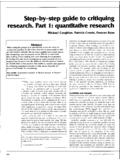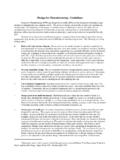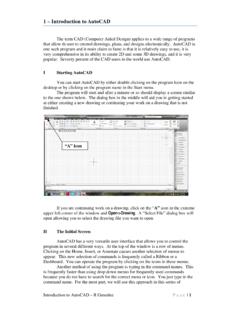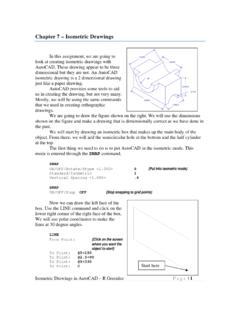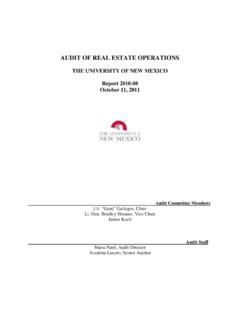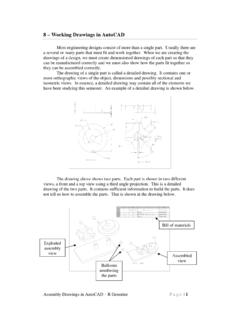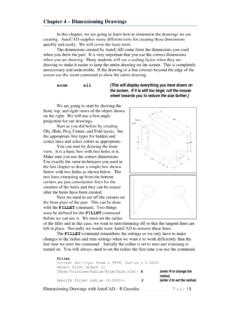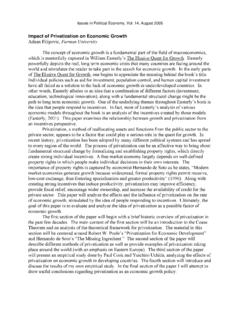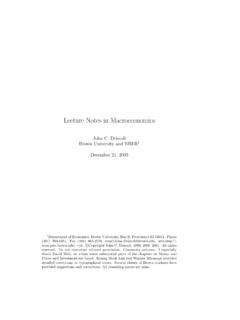Transcription of Mankiw: Macroeconomics. Fourth Edition.
1 mankiw : macroeconomics . Fourth 8: The Open mankiw develops his analysis of the trade balance and exchange ratedetermination separately, I find that it is easier to look at them at the same timeand that is what we do in changes in the trade balances are easier to understand if we observethe changes in the exchange foreign trade has increased, the interdependence of countries has in terms of a small open identities reveal a key insight: The flow of goods and services acrossnational borders is closely related to the flow of funds to finance 8-1: Imports and exports as a percentage of output: 1997, p. International Flows of Capital and an open economy, a country s spending in any given year does not have to equalits output of goods and role of net country s output consist of expenditures , , , can be restated as Y= C + I + G + = EX - exports (NX or trade balance): Exports minus = Y - (C+ I + G) Exports = Output - Domestic output exceeds domestic spending, we export the difference: net exportsare output falls short of domestic spending, we import the difference: netexports are foreign investment and the trade is a very simple but powerful foreign investment (S - I): The excess of domestic saving over domestic - I = foreign investment = the trade balance, which is the same as(1)Capital Account = - Current national income accounts identity shows that the internationalflow of funds to finance capital accumulation and the internationalMankiw: macroeconomics .
2 Fourth 8: The Open 2flow of goods and services are two sides of the same flows can take many forms such as investments in equitymarkets as well as in real and Investment in a Small Open effect, all countries including the US are interest rate: The real interest rate prevailing in world financial , it is based on global supply and applies for small open = r* the real rate is a constant, market rates will vary based oninflationary expectations, taxes and risks in the is often ignored in many media discussions of capital model of a small open economy has three key output of the economy Y is fixed by the factors of production and theproduction F(K,L) C is positively related to disposable income Y - (Y-T) is negatively related to the real interest rate I(r) , the trade balance is determined by the difference between savingand investment at the world interest = S - I(r*) 8-2: Saving and investment in a small open economy, p.
3 Policies influence the trade policy at from balanced trade, a change in fiscal policy that reducesnational saving leads to a trade 8-3: A fiscal expansion at home in a small openeconomy, p. : The twin deficits, p. 8-4: Saving, investment, the trade balance, and thebudget deficit: the experience, p. 202.(1)This is an important policy increase in the world interest rate due to a fiscal expansionabroad leads to a trade 8-5: A fiscal expansion in a small open economy, p. in investment : macroeconomics . Fourth 8: The Open outward shift in the investment schedule causes a trade 8-6: A shift in the investment schedule in a small open economy, p. economic central message of our model of the open economy is that the flow ofgoods and services measured the trade balance is inextricably connected tothe flow of funds for capital accumulation measured by net trade deficit is not a problem itself, but perhaps a symptom of a and real exchange nominal exchange rate: The relative price of the currency of two real exchange rate: The relative price of the goods of two is sometimes called the terms of : How newspapers report the exchange rate, p.
4 Exchange rate= nominal ex. rate times the ratio of price = e x (P/P*)(1)g in the real exchange rate(2)e is the nominal exchange rate(3)P = domestic prices(4)P* = foreign the real exchange rate is high, foreign goods are relatively cheapand domestic goods are relatively the real exchange rate is low, foreign goods are relativelyexpensive and domestic goods are relatively real exchange rate and the trade balance. 8-7: Net exports and the real exchange rate, p. response to a change in the real exchange rate can be determinants of the real exchange find that two forces determine the real exchange real exchange rate is related to net trade balance must equal net foreign 8-8: How the real exchange rate is determined, p. downward sloping line, NX, represents the net demand fordollars coming from foreigners who want dollars to buy our goods.(1)Think of it as a net demand for a country s net foreign investment curve (S - I) is vertical because it is notinfluenced by the exchange rate.
5 (1)Think of it as a net supply of a country s : macroeconomics . Fourth 8: The Open the equilibrium real exchange rate, the supply of dollars availablefor net foreign investment balanced the demand for dollars byforeign buying our net policies influence the real exchange policy at increase in G leads to a reduction in S and a higher realexchange 8-9: The impact of expansionary fiscal policy at home on the real exchange rate, p. policy increase in the world interest rate leads to a reduction in I andan increase in NFI, so that the exchange rate 8-10: The impact of expansionary fiscal policy abroad on the real exchange rate, p. in investment increase in investment demand, reduces NFI driving up theexchange 8-11: The impact of an increase in investment demand on the real exchange rate, p. effects of trade is a good example of how a good understanding of macroeconomicsleads to different conclusions that you usually observe in the trade policies do not affect the trade balance, although theyaffect the exchange 8-12: The impact of protectionist trade policies on the real exchange rate, p.
6 Determinants of the nominal exchange in e= %change in g + ( *- )a. * = foreign inflationb. = domestic a country has a high rate of inflation relative to the US, a dollar will buyan increasing amount of the foreign currency over a country has a low rate of inflation relative to the US, a dollar will buy adecreasing amount of the foreign currency over : Inflation and nominal exchange rates, p. 8-13: Inflation differentials and the exchange rate, special case of purchasing-power parity: It states that if international arbitrage is possible, then a dollar must have the same purchasing power in every : macroeconomics . Fourth 8: The Open is based on the law of one , the real exchange rate is a is a long run has two important implications:(1)Since the net exports schedule is flat, changes in saving andinvestment do not influence the real or nominal exchangerates.(2)Since the real exchange rate is fixed, all changes in thenominal exchange rate result for changes in price is not a perfect description of the world because(1)many goods are not easily trade and (2)others are not perfect 8-14: Purchasing power parity, p.
7 : The Big Mac around the world, p. 8-1: Big Mac prices and the exchange rate: An application of Purchasing power parity, p. United States as a Large Open feels that the US is somewhere between a small open economy and aclosed see it as still being a small open : The Large Open is not important to understand this Foreign = NFI(r). 8-15: How Net Foreign Investment Depends on the InterestRate, p. 8-16: Two special cases, p. US interest rate is not fixed at the world level US is large enough to influence world financial markets is not perfectly for this new NFI function, the model of the large open economyresembles the model of the small open understand how the large open economy works, we need to considertwo key market for loanable funds and(1)Figure 8-17: The Market for Loanable Funds in theMankiw: macroeconomics . Fourth 8: The Open 6 Large Open Economy, p. 227.(2)S = I(r) + NFI(r).b. the market for foreign exchange.
8 (1)Figure 8-18: The Market for Foreign Exchange in theLarge Open Economy, p. 227.(2)NX ( ) = in the Large Open diagrams are needed for this equilibrium in the market for loanable duns, relationship between the equilibrium interest rate and netforeign investment equilibrium in the market for 8-19: The Equilibrium in the Large Open Economy, Policy at 8-20: A Reduction in National Saving in the LargeOpen Economy, p. in Investment 8-21: An Increase in Investment Demand in the LargeOpen Economy, p. 8-22: An Import Restriction in the Large OpenEconomy, p. in New Foreign 8-23: A Fall in New Foreign Investment in the LargeOpen Economy, p. 232.

